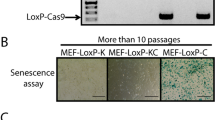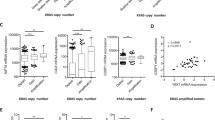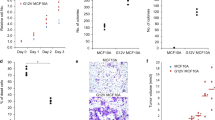Abstract
Induced transformation of mouse fibroblasts was carried out by releasing tetracycline-repressed expression of an oncogenic mutant of STAT3, STAT3-C, or of v-Src or Ha-Ras. At 15 days after derepression of each oncogene, DNA microarrays showed elevation (>3-fold) of a similar group of ∼25 mRNAs compared to untransformed cells. RT–PCR confirmed a number of these mRNA elevations. RNA samples were then analysed at intervals during the first 24 h after doxycycline removal to determine the time of early changes. Extensive changes were not observed by array analysis, except in v-Src-expressing cells where about 10 mRNAs were elevated threefold or more. However, RT–PCR did uncover changes in each derepressed cell type that included some of the changes observed after the 15-day transformation period. In addition, STAT3-C target genes such as BclXI and cyclin D1, which were not observed on array analysis, were elevated by RT–PCR analysis. We conclude, therefore, that early after oncogene induction, transcriptional changes, including those initiated by STAT3-C, may occur only in scarce mRNA and/or to a limited extent. However, with additional time and probably additional cell division, a new epigenetic state is established that is mirrored by a changed transcriptional profile emblematic of transformation by each of three oncogenes.
This is a preview of subscription content, access via your institution
Access options
Subscribe to this journal
Receive 50 print issues and online access
$259.00 per year
only $5.18 per issue
Buy this article
- Purchase on Springer Link
- Instant access to full article PDF
Prices may be subject to local taxes which are calculated during checkout



Similar content being viewed by others
References
Ayllon V and Rebollo A . (2000). Mol. Membr. Biol., 17, 65–73.
Baldi P and Long AD . (2001). Bioinformatics, 17, 509–519.
Bar-Sagi D . (2001). Mol. Cell. Biol., 21, 1441–1443.
Blume-Jensen P and Hunter T . (2001). Nature, 411, 355–365.
Bohmann D, Bos TJ, Admon A, Nishimura T, Vogt PK and Tjian R . (1987). Science, 238, 1386–1392.
Bourne HR, Wrischnik L and Kenyon C . (1990). Nature, 348, 678–679.
Boynton AL, Kleine LP and Whitfield JF . (1984). Cancer Lett., 21, 293–302.
Bromberg JF, Horvath CM, Besser D, Lathem WW and Darnell Jr JE . (1998). Mol. Cell. Biol., 18, 2553–2558.
Bromberg JF, Wrzeszczynska MH, Devgan G, Zhao Y, Pestell RG, Albanese C and Darnell Jr JE . (1999). Cell, 98, 295–303.
Brown PO and Botstein D . (1999). Nat. Genet., 21, 33–37.
Chen YC, Hayman MJ and Vogt PK . (1977). Cell, 11, 513–521.
Cowley S, Paterson H, Kemp P and Marshall CJ . (1994). Cell, 77, 841–852.
Darnell Jr JE . (2002). Nat. Rev. Cancer, 2, 740–749.
Duzgunes N and Felgner PL . (1993). Methods Enzymol., 221, 303–306.
Farmer G, Bargonetti J, Zhu H, Friedman P, Prywes R and Prives C . (1992). Nature, 358, 83–86.
Freundlieb S, Schirra-Muller C and Bujard H . (1999). J. Gene Med., 1, 4–12.
Geiger B, Tokuyasu KT and Singer SJ . (1979). Proc. Natl. Acad. Sci. USA, 76, 2833–2837.
Gossen M and Bujard H . (1992). Proc. Natl. Acad. Sci. USA, 89, 5547–5551.
Grandis JR, Drenning SD, Chakraborty A, Zhou MY, Zeng Q, Pitt AS and Tweardy DJ . (1998). J. Clin. Invest., 102, 1385–1392.
Joneson T and Bar-Sagi D . (1997). J. Mol. Med., 75, 587–593.
Kern SE, Kinzler KW, Bruskin A, Jarosz D, Friedman P, Prives C and Vogelstein B . (1991). Science, 252, 1708–1711.
Laemmli UK . (1970). Nature, 227, 680–685.
Levy DE and Darnell Jr JE . (2002). Nat. Rev. Mol. Cell. Biol., 3, 651–662.
Malek RL, Irby RB, Guo QM, Lee K, Wong S, He M, Tsai J, Frank B, Liu ET, Quackenbush J, Jove R, Yeatman TJ and Lee NH . (2002). Oncogene, 21, 7256–7265.
Naef F, Hacker CR, Patil N and Magnasco M . (2002). Genome Biol., 3, research0018.1–research0018.11.
Naef F, Socci ND and Magnasco M . (2003). Bioinformatics, 19, 178–184.
Niu G, Wright KL, Huang M, Song L, Haura E, Turkson J, Zhang S, Wang T, Sinibaldi D, Coppola D, Heller R, Ellis LM, Karras J, Bromberg J, Pardoll D, Jove R and Yu H . (2002). Oncogene, 21, 2000–2008.
Paulus W, Baur I, Boyce FM, Breakefield XO and Reeves SA . (1996). J. Virol., 70, 62–67.
Shen Y, Devgan G, Darnell Jr JE and Bromberg JF . (2001). Proc. Natl. Acad. Sci. USA, 98, 1543–1548.
St-Johnston D and Nusslein-Volhard C . (1992). Cell, 68, 201–219.
Staudt LM . (2003). N. Engl. J. Med., 348, 1777–1785.
Traverse S, Cohen P, Paterson H, Marshall C, Rapp U and Grand RJ . (1993). Oncogene, 8, 3175–3181.
Treisman R . (1996). Curr. Opin. Cell Biol., 8, 205–215.
Turkson J, Bowman T, Garcia R, Caldenhoven E, De Groot RP and Jove R . (1998). Mol. Cell. Biol., 18, 2545–2552.
Tusher VG, Tibshirani R and Chu G . (2001). Proc. Natl. Acad. Sci. USA, 98, 5116–5121.
Varmus HE . (1987). Science, 238, 1337–1339.
Vogt PK . (2001). Oncogene, 20, 2365–2377.
Vogt PK, Bos TJ and Doolittle RF . (1987). Proc. Natl. Acad. Sci. USA, 84, 3316–3319.
Yu CL, Meyer DJ, Campbell GS, Larner AC, Carter-Su C, Schwartz J and Jove R . (1995). Science, 269, 81–83.
Zambetti GP, Bargonetti J, Walker K, Prives C and Levine AJ . (1992). Genes Dev., 6, 1143–1152.
Acknowledgements
This work was supported by NIH grants AI32489 and AI34420 to JED. KP is a Human Frontier Science Program fellow. We thank Lois Cousseau for assistance with manuscript preparation.
Author information
Authors and Affiliations
Corresponding author
Additional information
Supplementary Information accompanies the paper on Oncogene website (http://www.nature.com/onc).
Rights and permissions
About this article
Cite this article
Paz, K., Socci, N., van Nimwegen, E. et al. Transformation fingerprint: induced STAT3-C, v-Src and Ha-Ras cause small initial changes but similar established profiles in mRNA. Oncogene 23, 8455–8463 (2004). https://doi.org/10.1038/sj.onc.1207803
Received:
Revised:
Accepted:
Published:
Issue Date:
DOI: https://doi.org/10.1038/sj.onc.1207803
Keywords
This article is cited by
-
From Rous sarcoma virus to plasminogen activator, src oncogene and cancer management
Oncogene (2011)
-
Cellular processes of v-Src transformation revealed by gene profiling of primary cells - Implications for human cancer
BMC Cancer (2010)
-
Stat3 up-regulates expression of nicotinamide N-methyltransferase in human cancer cells
Journal of Cancer Research and Clinical Oncology (2008)
-
A novel activating function of c-Src and Stat3 on HGF transcription in mammary carcinoma cells
Oncogene (2006)



